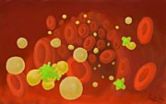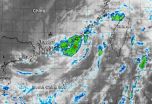Trapping light: A long lifetime in a very small place
Researchers create an innovative light-trapping nanostructure using a genetic-inspired approach
2014-06-16
(Press-News.org) Physicists at the University of Rochester have created a silicon nanocavity that allows light to be trapped longer than in other similarly-sized optical cavities. An innovative design approach, which mimics evolutionary biology, allowed them to achieve a 10-fold improvement on the performance of previous nanocavities.
In a paper published in Applied Physics Letters today and featured on the cover, the scientists demonstrate they have confined light in a nanocavity – a nanostructured region of a silicon wafer – for nanoseconds. Typically light would travel several meters in that time, but instead the nanostructure confined light in a region no bigger than one one hundredth the width of a human hair – roughly one-half millionth of a meter.
"Light holds the key to some of nature's deepest secrets, but it is very challenging to confine it in small spaces," says Antonio Badolato, professor of physics at the University of Rochester and corresponding author of the Applied Physics Letters paper. "Light has no rest mass or charge that allow forces to act on it and trap it; it has to be done by carefully designing tiny mirrors that reflect light millions of times."
Nanocavities are key components of nanophotonics circuits and Badolato explains that this new approach will help implement a new-generation of highly integrated nanophotonics structures.
Researchers are interested in confining light because it allows for easier manipulation and coupling to other devices. Trapping light also allows researchers to study it at its fundamental level, that is, at the state when light behaves as a particle (an area that led to the 2012 Nobel Prize in Physics).
Until now, researchers have been using educated-guess procedures to design the light-trapping nanostructures. However in this case, the team of researchers – which included lead author and Badolato's Ph.D. student, Yiming Lai, and groups from the Ecole Polytechnique Federale de Lausanne, Switzerland, and the Universita di Pavia, Italy– perfected a numerical technique that lead to the design improvement. Their computational approach allowed them to search for the optimal combination of parameters among thousand of realizations using a "genetic" (or "evolutionary") algorithm tool.
The principle behind the genetic approach is to regard each new nanocavity as an individual in a population. The individuals mutate and "breed," meaning that two single structures combine to create a new one that is a cross between the two "parents." As new generations succeeded one another, the algorithm selected the fittest ones in each generation, in this case, the ones that exhibited the longest trapping time (i.e. highest quality factor).
Integrated nanophotonics is a new and rapidly growing field of research laying at the intersection of photonics, nanotechnology, and materials science. In the near future, nanophotonics circuits will enable disruptive technologies ranging from telecommunications to biosensing, and because they can process pulses of light extremely fast and with very low energy consumption, they hold the potential to replace conventional information-handling systems.
The results shown by Badolato and his colleagues demonstrate one of the highest quality factors ever measured in nanocavities while maintaining a very small footprint. By keeping the nanocavities so small while trapping light so efficiently it becomes possible to create devices with ultra-dense integration – a desired characteristic in the fabrication of optical nanocircuits.
The extreme sensitivity of these nanocavities to tiny changes in the environment, for example a virus attaching near the area where light is trapped, makes these devices particularly appealing for biosensing. By using these highly sensible nanocavities, such a biosensing device could detect minute quantities of these biomaterials by analyzing a single drop of blood. Badolato's group is now starting a collaboration with researchers at the University of Rochester's Medical Center to exploit this interesting property with the new nanocavities.
INFORMATION:
ELSE PRESS RELEASES FROM THIS DATE:
Broccoli sprout drink enhances detoxification of air pollutants in clinical trial in China
2014-06-16
A clinical trial involving nearly 300 Chinese men and women residing in one of China's most polluted regions found that daily consumption of a half cup of broccoli sprout beverage produced rapid, significant and sustained higher levels of excretion of benzene, a known human carcinogen, and acrolein, a lung irritant. Researchers from the Johns Hopkins Bloomberg School of Public Health, working with colleagues at several U.S. and Chinese institutions, used the broccoli sprout beverage to provide sulforaphane, a plant compound already demonstrated to have cancer preventive ...
Genetic influence on pulmonary function: Six further genes identified
2014-06-16
In their investigations or so-called genome-wide association studies, the team of researchers compared the genetic profile of study participants to the forced vital capacity (FVC), a volume parameter of lung function. Six gene loci here displayed a clear association with the FVC values. Involvement in lung development or certain pulmonary diseases is furthermore suspected for these genes.
Better understanding of the association between genes, lung function and lung diseases
The identified genes open up new molecular biological approaches for a better understanding of ...
Children in low-income homes do better in kindergarten if moms work when they are babies
2014-06-16
WASHINGTON - Kindergarteners from lower-income families who were babies when their mothers went to work outside the home fare as well as or even better than children who had stay-at-home moms, according to new research published by the American Psychological Association.
This finding, in a study published in APA's journal Developmental Psychology, is contrary to the findings of previous studies of children born two to three decades ago. Family income is apparently a key factor, with the new research finding children from low-income families had slightly higher cognitive ...
E-cigarettes far less harmful than cigarettes, says Lancet researcher at INFORMS Conference
2014-06-16
A London School of Economics researcher examining the public and private dangers of drugs argues against demonizing e-cigarettes in a presentation being given at a conference of the Institute for Operations Research and the Management Sciences (INFORMS). He also calls on public officials to recognize that alcohol causes greater harm than other recreational drugs and more public attention should be paid to controlling its harmful effects.
Lawrence D. Phillips, an emeritus professor at the London School of Economics, will present his research group's findings about the relative ...
Lipids help to fight leukemia
2014-06-16
T cells use a novel mechanism to fight leukemia. They may recognize unique lipids produced by cancer cells and kill tumor cells expressing these lipid molecules. A study conducted by researchers at the University of Basel shows that a tumor-associated lipid stimulates specific T cells, which efficiently kill leukemia cells both in vitro and in animal models. The results have been published in the Journal of Experimental Medicine.
Leukemias are cancer diseases affecting blood cells . Acute leukemias prevent development of normal bold cells and thereby are severe life-threatening ...
Cellular force that drives allergy and asthma can be blocked by interferon
2014-06-16
DALLAS – June 16, 2014 – A mechanism that could underlie the development of cells that drive asthma and allergies has been uncovered by immunology researchers at UT Southwestern Medical Center.
Asthma and allergies are both driven by an inappropriate activation of the immune system, primarily a subtype of white blood cells known as T helper 2 cells, or Th2 cells. These cells are normally responsible for defense against parasites, but are also the main culprits behind the symptoms of asthma and allergies.
Dr. David Farrar, Associate Professor of Immunology and Molecular ...
Studies in family planning publishes special issue on unmet need
2014-06-16
NEW YORK, NY (16 June 2014) — Studies in Family Planning, a leading journal published by the Population Council, released "Unmet Need for Family Planning"—a special issue featuring ten articles, including a comprehensive introduction to the topic of unmet need. Distinguished researchers explore trends related to unmet need for contraception, and many articles point to practical strategies for increasing contraceptive knowledge and uptake, and for overcoming barriers that prevent women from practicing contraception.
"Unmet need has been an important indicator for measuring ...
NASA catches short-lived tropical cyclone Hagibis landfalling in China
2014-06-16
Tropical storm Hagibis only lived through 6 bulletins issued by the Joint Typhoon Warning Center in its short lifetime in the northwestern Pacific Ocean. The final bulletin was issued on June 15 at 1500 UTC (11 a.m. EDT) after Hagibis made landfall in China.
Hagibis was born in the South China Sea on June 14 at 0900 UTC (5 a.m. EDT) near 20.7 north latitude and 117.0 east longitude, about 183 nautical miles east-southeast of Hong Kong when a low pressure system quickly consolidated and maximum sustained winds jumped to 35 knots (40 mph/62 kph). Hagibis is the seventh ...
How sperm get into the zona
2014-06-16
Before it can fertilize an egg, a sperm has to bind to and bore through an outer egg layer known as the zona pellucida. Despite decades of research, some of the biological mechanisms behind this process remain unclear. A study in The Journal of Cell Biology now identifies the protein in the zona pellucida that sperm latch onto.
The zona pellucida protects the egg and the early embryo before implantation. Its structure seems simple—in humans it contains four kinds of glycoproteins, and in mice it only contains three. But researchers haven't been able to identify the sperm's ...
High number of fatalities despite unchanged level of armed conflicts
2014-06-16
At 33, conflicts in the world last year increased by one compared to 2012. This is reported by peace researchers at Uppsala University's Conflict Data Program. The number has remained stable over the past decade. 2012 saw an increase in the number of battle-related deaths with the number of casualties in Syria completely overshadowing any other ongoing conflict. In 2012, two out of five people dying in battles, died in Syria.
The new dataset is described by peace researchers at Uppsala University's Conflict Data Program (UCDP) in an article which will soon be published ...
LAST 30 PRESS RELEASES:
Making lighter work of calculating fluid and heat flow
Normalizing blood sugar can halve heart attack risk
Lowering blood sugar cuts heart attack risk in people with prediabetes
Study links genetic variants to risk of blinding eye disease in premature infants
Non-opioid ‘pain sponge’ therapy halts cartilage degeneration and relieves chronic pain
AI can pick up cultural values by mimicking how kids learn
China’s ecological redlines offer fast track to 30 x 30 global conservation goal
Invisible indoor threats: emerging household contaminants and their growing risks to human health
Adding antibody treatment to chemo boosts outcomes for children with rare cancer
Germline pathogenic variants among women without a history of breast cancer
Tanning beds triple melanoma risk, potentially causing broad DNA damage
Unique bond identified as key to viral infection speed
Indoor tanning makes youthful skin much older on a genetic level
Mouse model sheds new light on the causes and potential solutions to human GI problems linked to muscular dystrophy
The Journal of Nuclear Medicine ahead-of-print tip sheet: December 12, 2025
Smarter tools for peering into the microscopic world
Applications open for funding to conduct research in the Kinsey Institute archives
Global measure underestimates the severity of food insecurity
Child survivors of critical illness are missing out on timely follow up care
Risk-based vs annual breast cancer screening / the WISDOM randomized clinical trial
University of Toronto launches Electric Vehicle Innovation Ontario to accelerate advanced EV technologies and build Canada’s innovation advantage
Early relapse predicts poor outcomes in aggressive blood cancer
American College of Lifestyle Medicine applauds two CMS models aligned with lifestyle medicine practice and reimbursement
Clinical trial finds cannabis use not a barrier to quitting nicotine vaping
Supplemental nutrition assistance program policies and food insecurity
Switching immune cells to “night mode” could limit damage after a heart attack, study suggests
URI-based Global RIghts Project report spotlights continued troubling trends in worldwide inhumane treatment
Neutrophils are less aggressive at night, explaining why nighttime heart attacks cause less damage than daytime events
Menopausal hormone therapy may not pose breast cancer risk for women with BRCA mutations
Mobile health tool may improve quality of life for adolescent and young adult breast cancer survivors
[Press-News.org] Trapping light: A long lifetime in a very small placeResearchers create an innovative light-trapping nanostructure using a genetic-inspired approach




